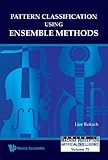Pattern classification using ensemble methods / Lior Rokach.
Material type: TextSeries: Series in machine perception and artificial intelligence ; v. 75.Publication details: Singapore ; Hackensack, N.J. : World Scientific Pub. Co., ©2010.Description: 1 online resource (xv, 225 pages) : illustrationsContent type:
TextSeries: Series in machine perception and artificial intelligence ; v. 75.Publication details: Singapore ; Hackensack, N.J. : World Scientific Pub. Co., ©2010.Description: 1 online resource (xv, 225 pages) : illustrationsContent type: - text
- computer
- online resource
- 9789814271073
- 9814271071
- 1282757857
- 9781282757851
- 9786612757853
- 661275785X
- Pattern recognition systems
- Algorithms
- Machine learning
- Pattern recognition systems -- Classification
- Set theory
- Pattern Recognition, Automated
- Algorithms
- Reconnaissance des formes (Informatique) -- Classification
- Théorie des ensembles
- Reconnaissance des formes (Informatique)
- Algorithmes
- Apprentissage automatique
- algorithms
- COMPUTERS -- Optical Data Processing
- Algorithms
- Machine learning
- Pattern recognition systems
- Mustererkennung
- 006.4 22
- TK7882.P3 R65 2010eb
| Item type | Home library | Collection | Call number | Materials specified | Status | Date due | Barcode | |
|---|---|---|---|---|---|---|---|---|
 Electronic-Books
Electronic-Books
|
OPJGU Sonepat- Campus | E-Books EBSCO | Available |
Includes bibliographical references (pages 185-222) and index.
1. Introduction to pattern classification. 1.1. Pattern classification. 1.2. Induction algorithms. 1.3. Rule induction. 1.4. Decision trees. 1.5. Bayesian methods. 1.6. Other induction methods -- 2. Introduction to ensemble learning. 2.1. Back to the roots. 2.2. The wisdom of crowds. 2.3. The bagging algorithm. 2.4. The boosting algorithm. 2.5. The AdaBoost algorithm. 2.6. No free lunch theorem and ensemble learning. 2.7. Bias-variance decomposition and ensemble learning. 2.8. Occam's razor and ensemble learning. 2.9. Classifier dependency. 2.10. Ensemble methods for advanced classification tasks -- 3. Ensemble classification. 3.1. Fusions methods. 3.2. Selecting classification. 3.3. Mixture of experts and meta learning -- 4. Ensemble diversity. 4.1. Overview. 4.2. Manipulating the inducer. 4.3. Manipulating the training samples. 4.4. Manipulating the target attribute representation. 4.5. Partitioning the search space. 4.6. Multi-inducers. 4.7. Measuring the diversity -- 5. Ensemble selection. 5.1. Ensemble selection. 5.2. Pre selection of the ensemble size. 5.3. Selection of the ensemble size while training. 5.4. Pruning -- post selection of the ensemble size -- 6. Error correcting output codes. 6.1. Code-matrix decomposition of multiclass problems. 6.2. Type I -- training an ensemble given a code-matrix. 6.3. Type II -- adapting code-matrices to the multiclass problems -- 7. Evaluating ensembles of classifiers. 7.1. Generalization error. 7.2. Computational complexity. 7.3. Interpretability of the resulting ensemble. 7.4. Scalability to large datasets. 7.5. Robustness. 7.6. Stability. 7.7. Flexibility. 7.8. Usability. 7.9. Software availability. 7.10. Which ensemble method should be used?
Researchers from various disciplines such as pattern recognition, statistics, and machine learning have explored the use of ensemble methodology since the late seventies. Thus, they are faced with a wide variety of methods, given the growing interest in the field. This book aims to impose a degree of order upon this diversity by presenting a coherent and unified repository of ensemble methods, theories, trends, challenges and applications. The book describes in detail the classical methods, as well as the extensions and novel approaches developed recently. Along with algorithmic descriptions of each method, it also explains the circumstances in which this method is applicable and the consequences and the trade-offs incurred by using the method.
Print version record.
English.
eBooks on EBSCOhost EBSCO eBook Subscription Academic Collection - Worldwide
There are no comments on this title.

